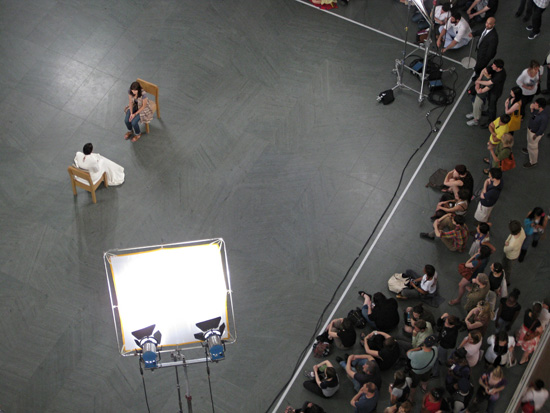
Inevitably, the fast pace of consumerism is accompanied by the tantalizing promise of slow time—Allen Ginsberg once complained of a heart attack en route to his weekly meditation.
Just as the arts were reinvented in the age of the camera, so too must they be in the age of accelerated time. If the internet and the touch screen represent the apparatuses of our age, then the material and the prolonged have become a niche for the discursive and formal role of the arts. Much like a spa, the arts play host to a malnourished subject eager to experience something nostalgically other. Slow time and tangible bodies become so rare experientially that their aesthetic value finds a home in the cul-de-sac of scarcity that is art.
Since the advent of mechanical production, the arts have been the space in which the hard-to-find seeks refuge. And while the art market has been much discussed, we now find another form of scarcity in forms of experience. At times in tension, at times in collusion with capitalist scarcity, the scarcity of experience encourages forms of art that are not as easily distributed as—and thus more distinguishable from—the mass produced goods of the broader market. Massive installations, sculptures, performance, civic institutions (the museum), time-based relational aesthetics all find value in their experiential distinction from larger markets. Museums offer special opportunities to experience the body in space. In this spasmodic era, we find the arts recalibrated as a temporal, spatial, and bodily escape.
This kind of shifted aesthetic disposition resists not only the pace of the information economy, but, perhaps more importantly, our very ability to consume our experience. If we are frantic, it is only because we need to be so in order to keep up. Slowness does not only characterize a mode of consumption, but also a mode of behavior. To that end, we now find numerous forms of contemporary art that gain resonance by tweaking behavioral codes with regard to the body and temporality. Some projects comprise bite-sized moments that are quickly consumed, context-specific chunks of experience that enter the mind and dissipate quickly, in harmony with the frantic and the contingent. They are brain candy and they are meant to be delicious. While there is nothing new in describing numerous forms of participatory art as mere products of an information economy that caters to the needs of power, their temporal qualities certainly play a role as pithy and poetic correspondences to capitalist consumption.
-- EXCERPT FROM "CONTRACTIONS OF TIME: ON SOCIAL PRACTICE FROM A TEMPORAL PERSPECTIVE" BY NATO THOMPSON IN E-FLUX'S JOURNAL, ISSUE #20, NOVEMBER 2011